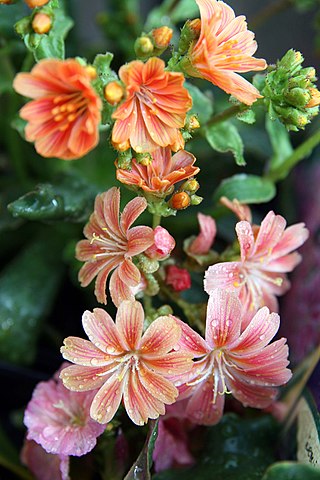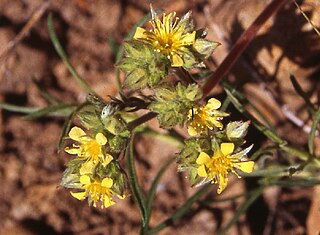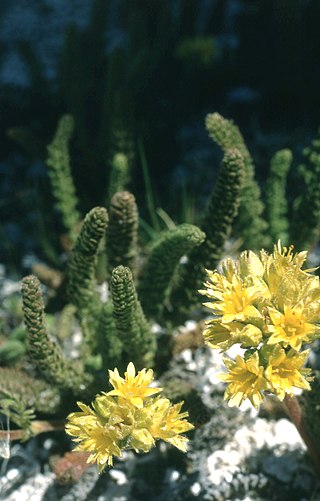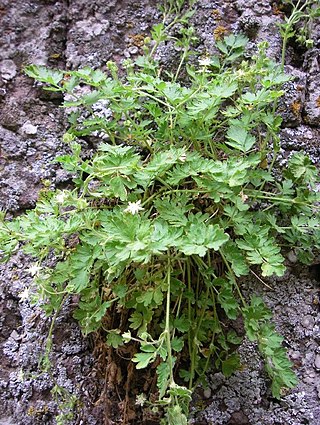
Dasiphora fruticosa is a species of hardy deciduous flowering shrub in the family Rosaceae, native to the cool temperate and subarctic regions of the northern hemisphere, often growing at high altitudes in mountains. Dasiphora fruticosa is still widely referenced in the horticultural literature under its synonym Potentilla fruticosa. Common names include shrubby cinquefoil, golden hardhack, bush cinquefoil, shrubby five-finger, widdy, kuril tea and tundra rose.

Potentilla indica, known commonly as mock strawberry, Indian-strawberry, or false strawberry, often referred to as a backyard strawberry, mainly in North America, is a flowering plant in the family Rosaceae. It has foliage and an aggregate accessory fruit similar to that of a true strawberry. It has yellow flowers, unlike the white or slightly pink flowers of true strawberries. It is native to eastern and southern Asia, but has been introduced to many other areas as a medicinal and an ornamental plant, subsequently naturalizing in many regions worldwide. It is considered invasive in some regions of the United States.

Lewisia is a plant genus, named for the American explorer Meriwether Lewis (1774-1809) who encountered the species in 1806. The native habitat of Lewisia species is rocky ground and cliffs in western North America. Native Americans ate the roots, which have also been used to treat sore throats.

Psorothamnus is a genus of plants in the legume family. These are shrubs and small trees. Many are known by the general common name indigo bush. Some are referred to as daleas, as this genus was once included in genus Dalea. These are generally thorny, thickly branched, strongly scented bushes. Most species bear lupinlike raceme inflorescences of bright purple legume flowers and gland-rich pods. Psorothamnus species are native to the southwestern United States and northern Mexico. The genus is paraphyletic and it has been proposed that the genus Psorodendron be reinstated to accommodate sections Xylodalea, Capnodendron, and Winnemucca.

Potentilla californica, also known as California horkelia, is a species of flowering plant in the rose family.

Potentilla douglasii is a species of flowering plant in the rose family known by several common names, including pinewoods horkelia and dusky horkelia. It is native to the western United States from California to Wyoming, where it is generally found in mountain forests and meadows.

Potentilla aperta, commonly known as Sierra Valley mousetail, is a species of flowering plant in the rose family.

Potentilla gordonii, commonly known as Gordon's mousetail, is a species of flowering plant in the rose family. It is native to the mountain ranges of the western United States from California to Montana.

Potentilla jaegeri, also known as Jaeger's mousetail and Jaeger's ivesia, is an uncommon species of flowering plant in the rose family.

Potentilla webberi, commonly known as wire mousetail and Webber's ivesia, is a species of flowering plant in the rose family. It is native to the United States, where it occurs in the northernmost part of the Sierra Nevada and the adjacent Modoc Plateau in California, its range extending just into Nevada.

Potentilla hispidula, commonly known as White Mountains horkelia, is a species of flowering plant in the rose family. It is endemic to the White Mountains, a small range of mountains that straddles the border between California and Nevada east of the Sierra Nevada. It is a resident of dry scrub and alpine and subalpine forest habitat.

Potentilla baileyi, commonly known as Bailey's ivesia, is a species of flowering plant in the rose family.

Lupinus brevicaulis is a species of lupine known by the common names shortstem lupine and sand lupine. It is native to the southwestern United States, including Oregon, California, Nevada, Utah, Colorado, Arizona, and New Mexico, where it grows in many types of sandy habitat.

Potentilla diversifolia or Potentilla × diversifolia is a species of flowering plant in the Rose Family (Rosaceae) known by the common names varileaf cinquefoil, different-leaved cinquefoil, and mountain meadow cinquefoil.

Geum rossii is a species of flowering plant in the rose family known by the common names Ross' avens and alpine avens. It is native to North America where its distribution spans northern Canada and the high mountains of the western United States. It grows at high-latitude and high-elevation habitat, including the Arctic and in alpine climates. There are three varieties. One, var. depressum, is endemic to Washington in the United States, where it is limited to the Wenatchee Mountains.

Astragalus limnocharis var. montii, synonym Astragalus montii, is a rare variety of flowering plant in the legume family. It is known by the common name Monti's milkvetch. It is endemic to Utah in the United States, where there are only three known populations. Under the synonym A. montii, it is a federally listed threatened species of the United States.

Potentilla rhypara, also known as grimy mousetail and grimy ivesia, is a species of flowering plant in the rose family. It is native to Oregon and Nevada in the United States.

Potentilla shockleyi, also known as sky mousetail, is a tiny species of herbaceous perennial plant in the rose family. It is native to the alpine zone of the Sierra Nevada mountain range in the western United States.

Drymocallis glandulosa, formerly Potentilla glandulosa, known by the common names Douglas' wood beauty and sticky cinquefoil, is a plant species in the family Rosaceae.

Dasiphora fruticosa var. veitchii is a flowering plant in the family Rosaceae, native to Sichuan and Yunnan in China. It was first described as the species Potentilla veitchii by Ernest Henry Wilson in 1911, after he had earlier introduced it into gardens in the United Kingdom. Its scientific name and status have varied, and remained "unresolved" according to the Royal Horticultural Society as of May 2022. In horticulture, it may also be found under the names Potentilla davurica var. veitchii and Potentilla fruticosa var. veitchii. It is cultivated as an ornamental flowering shrub.





















